2008 DODGE GRAND CARAVAN coolant temperature
[x] Cancel search: coolant temperaturePage 228 of 531
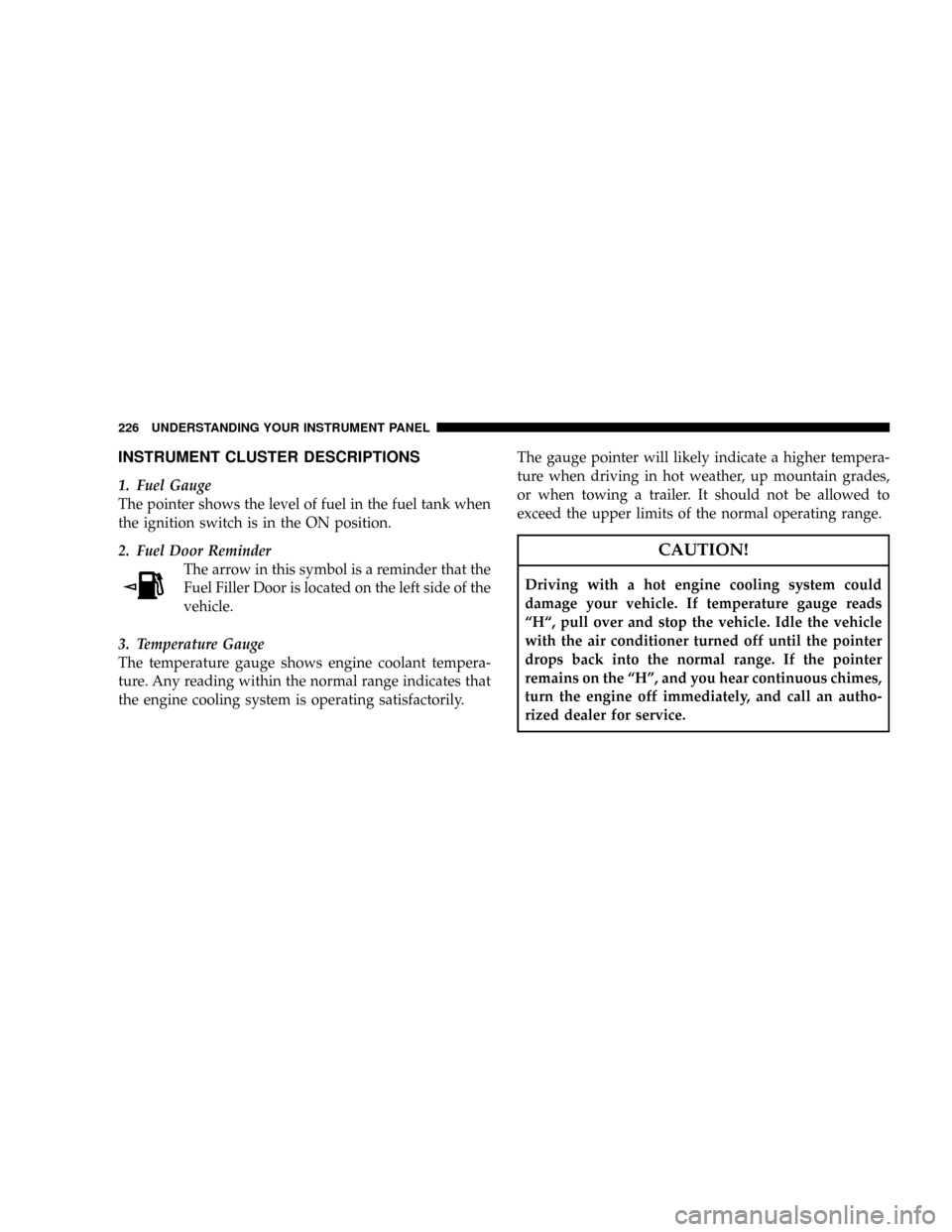
INSTRUMENT CLUSTER DESCRIPTIONS
1. Fuel Gauge
The pointer shows the level of fuel in the fuel tank when
the ignition switch is in the ON position.
2. Fuel Door Reminder
The arrow in this symbol is a reminder that the
Fuel Filler Door is located on the left side of the
vehicle.
3. Temperature Gauge
The temperature gauge shows engine coolant tempera-
ture. Any reading within the normal range indicates that
the engine cooling system is operating satisfactorily.The gauge pointer will likely indicate a higher tempera-
ture when driving in hot weather, up mountain grades,
or when towing a trailer. It should not be allowed to
exceed the upper limits of the normal operating range.
CAUTION!
Driving with a hot engine cooling system could
damage your vehicle. If temperature gauge reads
ªHª, pull over and stop the vehicle. Idle the vehicle
with the air conditioner turned off until the pointer
drops back into the normal range. If the pointer
remains on the ªHº, and you hear continuous chimes,
turn the engine off immediately, and call an autho-
rized dealer for service.
226 UNDERSTANDING YOUR INSTRUMENT PANEL
Page 240 of 531
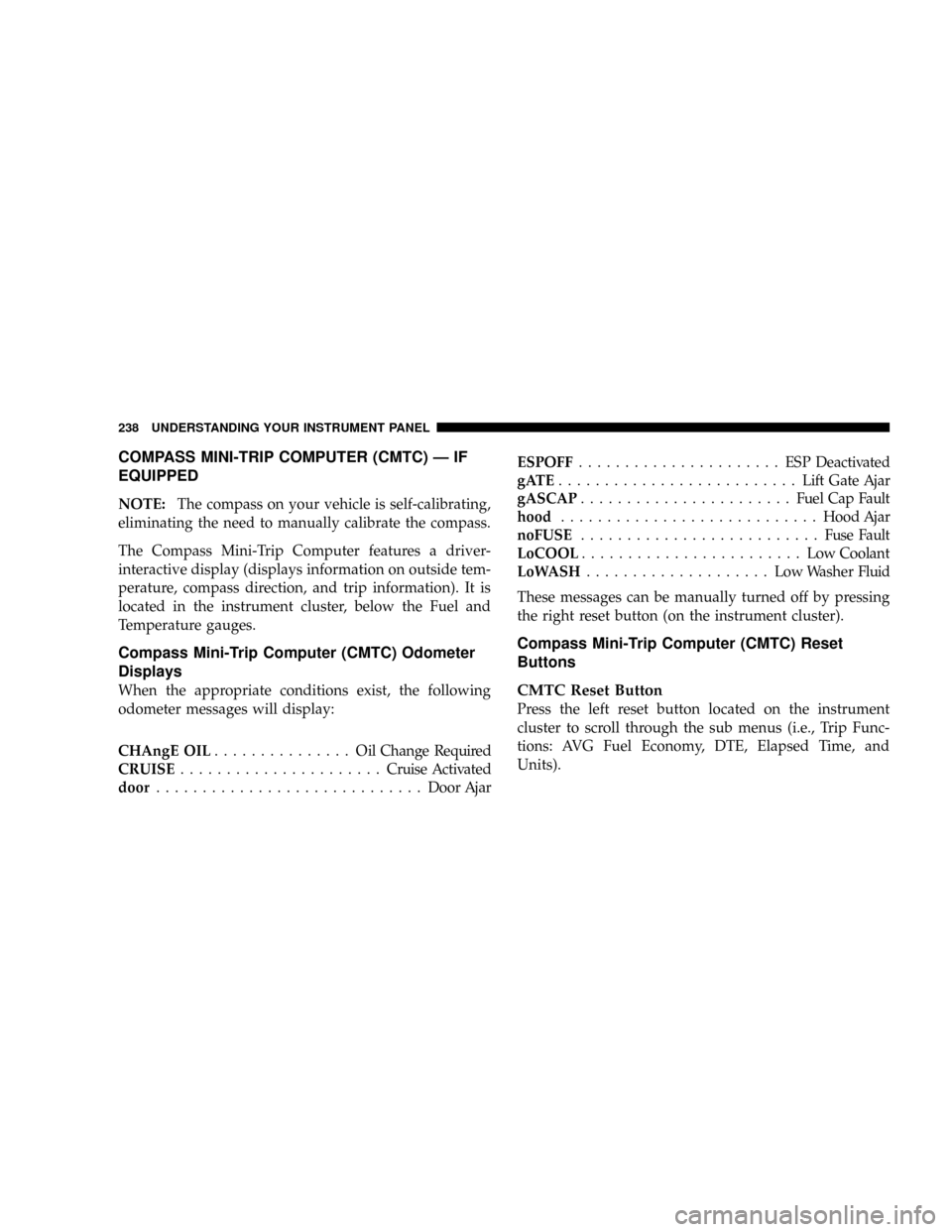
COMPASS MINI-TRIP COMPUTER (CMTC) Ð IF
EQUIPPED
NOTE:The compass on your vehicle is self-calibrating,
eliminating the need to manually calibrate the compass.
The Compass Mini-Trip Computer features a driver-
interactive display (displays information on outside tem-
perature, compass direction, and trip information). It is
located in the instrument cluster, below the Fuel and
Temperature gauges.
Compass Mini-Trip Computer (CMTC) Odometer
Displays
When the appropriate conditions exist, the following
odometer messages will display:
CHAngE OIL............... OilChange Required
CRUISE......................Cruise Activated
door.............................Door AjarESPOFF...................... ESPDeactivated
gATE..........................Lift Gate Ajar
gASCAP.......................Fuel Cap Fault
hood............................Hood Ajar
noFUSE..........................Fuse Fault
LoCOOL........................ LowCoolant
LoWASH.................... LowWasher Fluid
These messages can be manually turned off by pressing
the right reset button (on the instrument cluster).
Compass Mini-Trip Computer (CMTC) Reset
Buttons
CMTC Reset Button
Press the left reset button located on the instrument
cluster to scroll through the sub menus (i.e., Trip Func-
tions: AVG Fuel Economy, DTE, Elapsed Time, and
Units).
238 UNDERSTANDING YOUR INSTRUMENT PANEL
Page 413 of 531
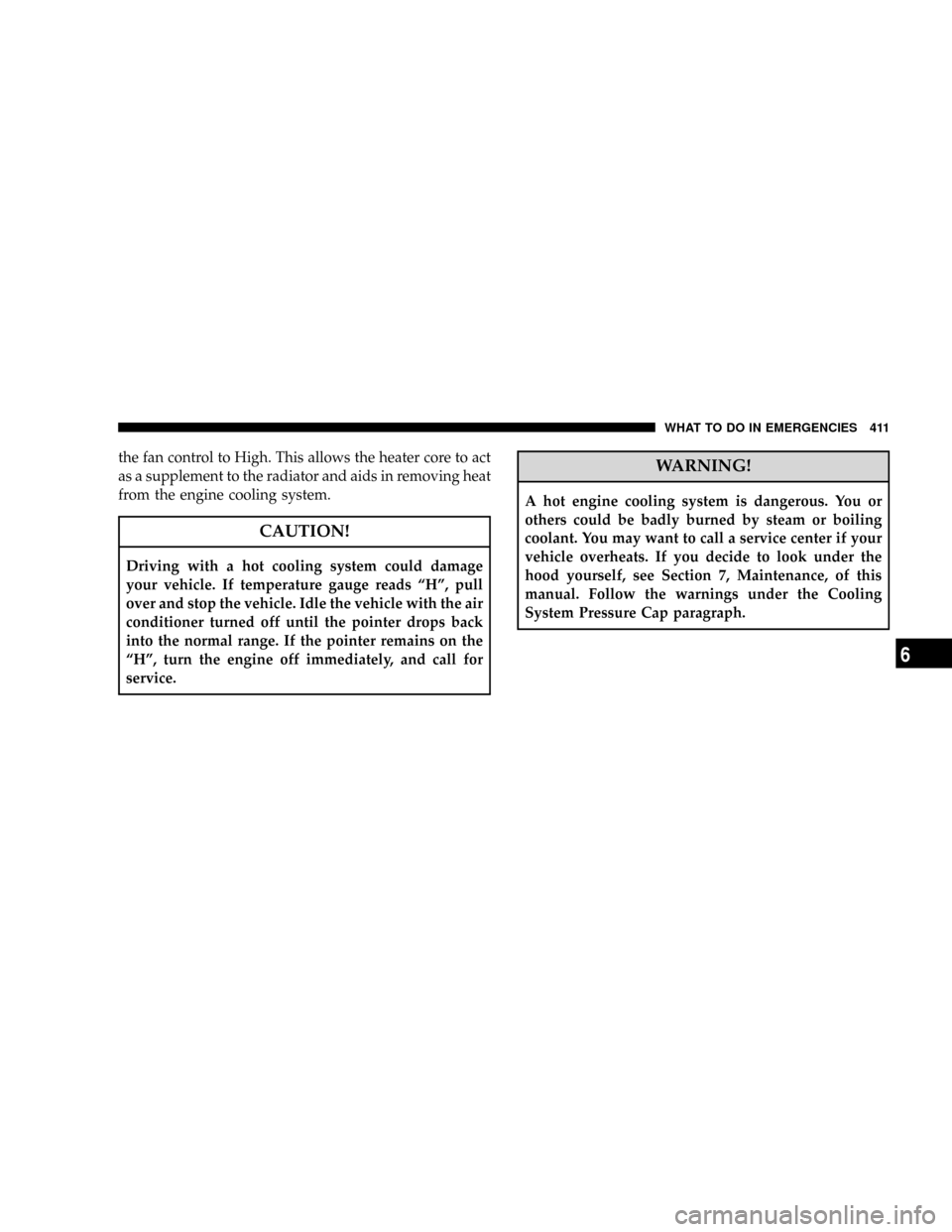
the fan control to High. This allows the heater core to act
as a supplement to the radiator and aids in removing heat
from the engine cooling system.
CAUTION!
Driving with a hot cooling system could damage
your vehicle. If temperature gauge reads ªHº, pull
over and stop the vehicle. Idle the vehicle with the air
conditioner turned off until the pointer drops back
into the normal range. If the pointer remains on the
ªHº, turn the engine off immediately, and call for
service.
WARNING!
A hot engine cooling system is dangerous. You or
others could be badly burned by steam or boiling
coolant. You may want to call a service center if your
vehicle overheats. If you decide to look under the
hood yourself, see Section 7, Maintenance, of this
manual. Follow the warnings under the Cooling
System Pressure Cap paragraph.
WHAT TO DO IN EMERGENCIES 411
6
Page 458 of 531
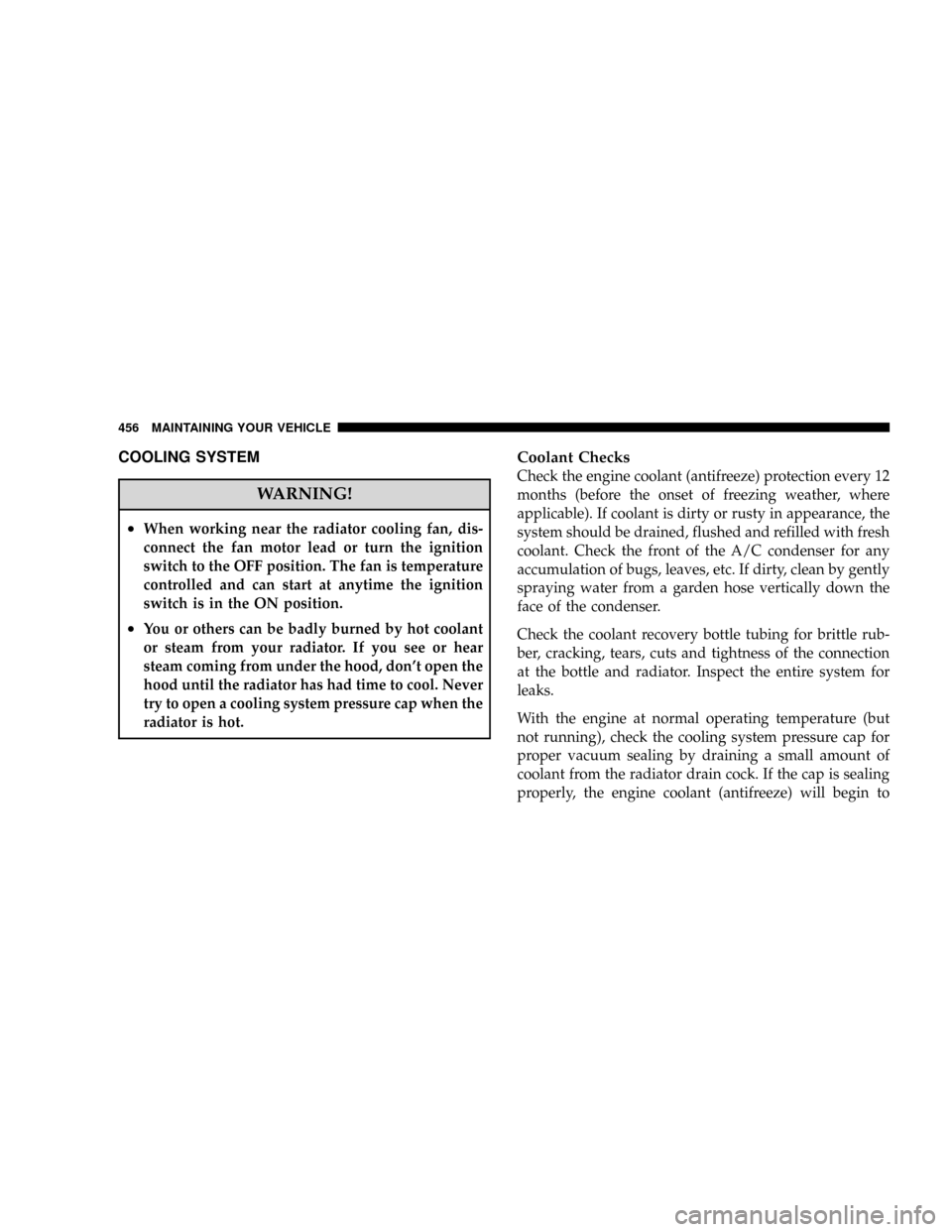
COOLING SYSTEM
WARNING!
²When working near the radiator cooling fan, dis-
connect the fan motor lead or turn the ignition
switch to the OFF position. The fan is temperature
controlled and can start at anytime the ignition
switch is in the ON position.
²You or others can be badly burned by hot coolant
or steam from your radiator. If you see or hear
steam coming from under the hood, don't open the
hood until the radiator has had time to cool. Never
try to open a cooling system pressure cap when the
radiator is hot.
Coolant Checks
Check the engine coolant (antifreeze) protection every 12
months (before the onset of freezing weather, where
applicable). If coolant is dirty or rusty in appearance, the
system should be drained, flushed and refilled with fresh
coolant. Check the front of the A/C condenser for any
accumulation of bugs, leaves, etc. If dirty, clean by gently
spraying water from a garden hose vertically down the
face of the condenser.
Check the coolant recovery bottle tubing for brittle rub-
ber, cracking, tears, cuts and tightness of the connection
at the bottle and radiator. Inspect the entire system for
leaks.
With the engine at normal operating temperature (but
not running), check the cooling system pressure cap for
proper vacuum sealing by draining a small amount of
coolant from the radiator drain cock. If the cap is sealing
properly, the engine coolant (antifreeze) will begin to
456 MAINTAINING YOUR VEHICLE
Page 460 of 531
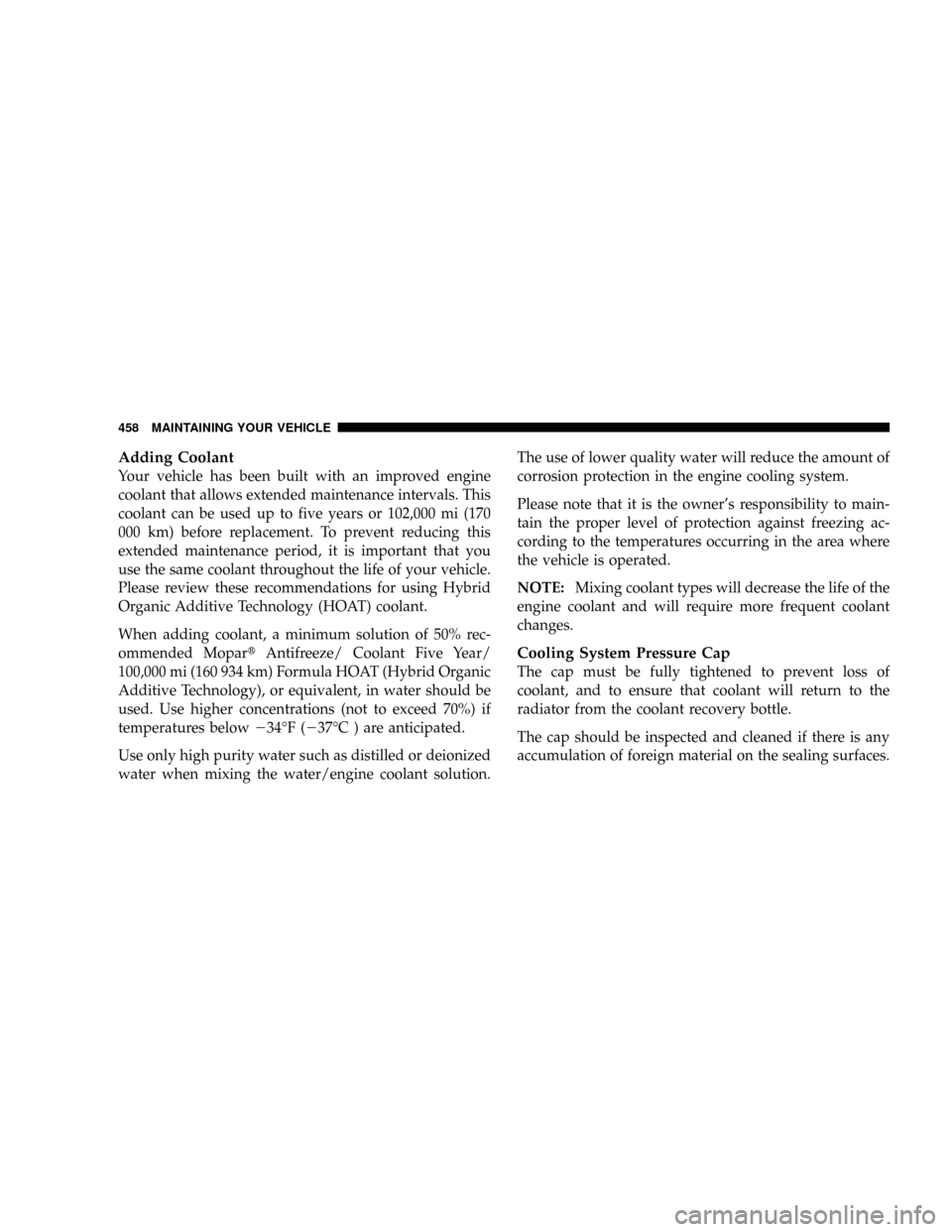
Adding Coolant
Your vehicle has been built with an improved engine
coolant that allows extended maintenance intervals. This
coolant can be used up to five years or 102,000 mi (170
000 km) before replacement. To prevent reducing this
extended maintenance period, it is important that you
use the same coolant throughout the life of your vehicle.
Please review these recommendations for using Hybrid
Organic Additive Technology (HOAT) coolant.
When adding coolant, a minimum solution of 50% rec-
ommended MopartAntifreeze/ Coolant Five Year/
100,000 mi (160 934 km) Formula HOAT (Hybrid Organic
Additive Technology), or equivalent, in water should be
used. Use higher concentrations (not to exceed 70%) if
temperatures below234ÉF (237ÉC ) are anticipated.
Use only high purity water such as distilled or deionized
water when mixing the water/engine coolant solution.The use of lower quality water will reduce the amount of
corrosion protection in the engine cooling system.
Please note that it is the owner's responsibility to main-
tain the proper level of protection against freezing ac-
cording to the temperatures occurring in the area where
the vehicle is operated.
NOTE:Mixing coolant types will decrease the life of the
engine coolant and will require more frequent coolant
changes.
Cooling System Pressure Cap
The cap must be fully tightened to prevent loss of
coolant, and to ensure that coolant will return to the
radiator from the coolant recovery bottle.
The cap should be inspected and cleaned if there is any
accumulation of foreign material on the sealing surfaces.
458 MAINTAINING YOUR VEHICLE
Page 461 of 531
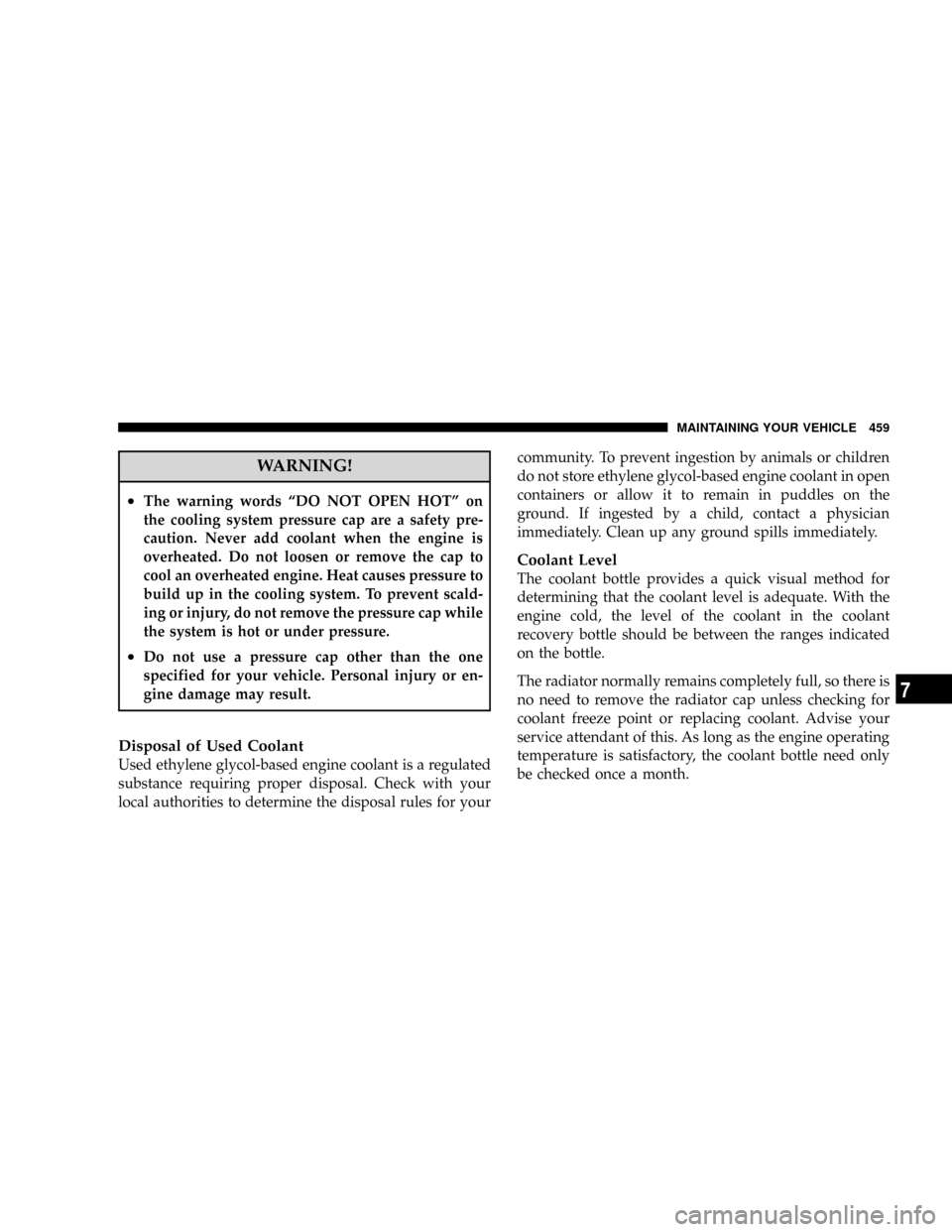
WARNING!
²The warning words ªDO NOT OPEN HOTº on
the cooling system pressure cap are a safety pre-
caution. Never add coolant when the engine is
overheated. Do not loosen or remove the cap to
cool an overheated engine. Heat causes pressure to
build up in the cooling system. To prevent scald-
ing or injury, do not remove the pressure cap while
the system is hot or under pressure.
²Do not use a pressure cap other than the one
specified for your vehicle. Personal injury or en-
gine damage may result.
Disposal of Used Coolant
Used ethylene glycol-based engine coolant is a regulated
substance requiring proper disposal. Check with your
local authorities to determine the disposal rules for yourcommunity. To prevent ingestion by animals or children
do not store ethylene glycol-based engine coolant in open
containers or allow it to remain in puddles on the
ground. If ingested by a child, contact a physician
immediately. Clean up any ground spills immediately.
Coolant Level
The coolant bottle provides a quick visual method for
determining that the coolant level is adequate. With the
engine cold, the level of the coolant in the coolant
recovery bottle should be between the ranges indicated
on the bottle.
The radiator normally remains completely full, so there is
no need to remove the radiator cap unless checking for
coolant freeze point or replacing coolant. Advise your
service attendant of this. As long as the engine operating
temperature is satisfactory, the coolant bottle need only
be checked once a month.
MAINTAINING YOUR VEHICLE 459
7
Page 515 of 531
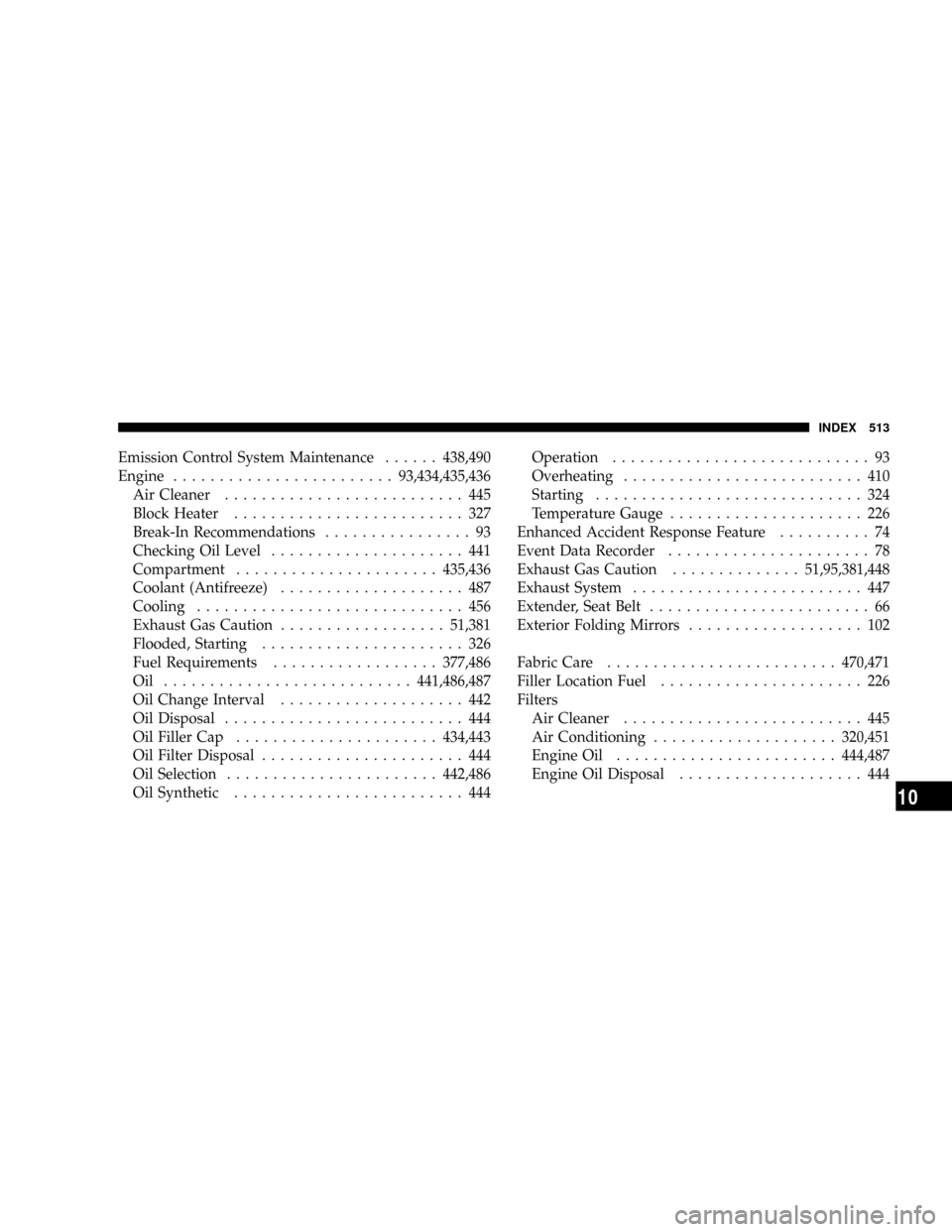
Emission Control System Maintenance......438,490
Engine........................93,434,435,436
Air Cleaner.......................... 445
Block Heater......................... 327
Break-In Recommendations................ 93
Checking Oil Level..................... 441
Compartment......................435,436
Coolant (Antifreeze).................... 487
Cooling............................. 456
Exhaust Gas Caution..................51,381
Flooded, Starting...................... 326
Fuel Requirements..................377,486
Oil ...........................441,486,487
Oil Change Interval.................... 442
Oil Disposal.......................... 444
Oil Filler Cap......................434,443
Oil Filter Disposal...................... 444
Oil Selection.......................442,486
Oil Synthetic......................... 444Operation............................ 93
Overheating.......................... 410
Starting............................. 324
Temperature Gauge..................... 226
Enhanced Accident Response Feature.......... 74
Event Data Recorder...................... 78
Exhaust Gas Caution..............51,95,381,448
Exhaust System......................... 447
Extender, Seat Belt........................ 66
Exterior Folding Mirrors................... 102
Fabric Care.........................470,471
Filler Location Fuel...................... 226
Filters
Air Cleaner.......................... 445
Air Conditioning....................320,451
Engine Oil........................444,487
Engine Oil Disposal.................... 444
INDEX 513
10
Page 517 of 531
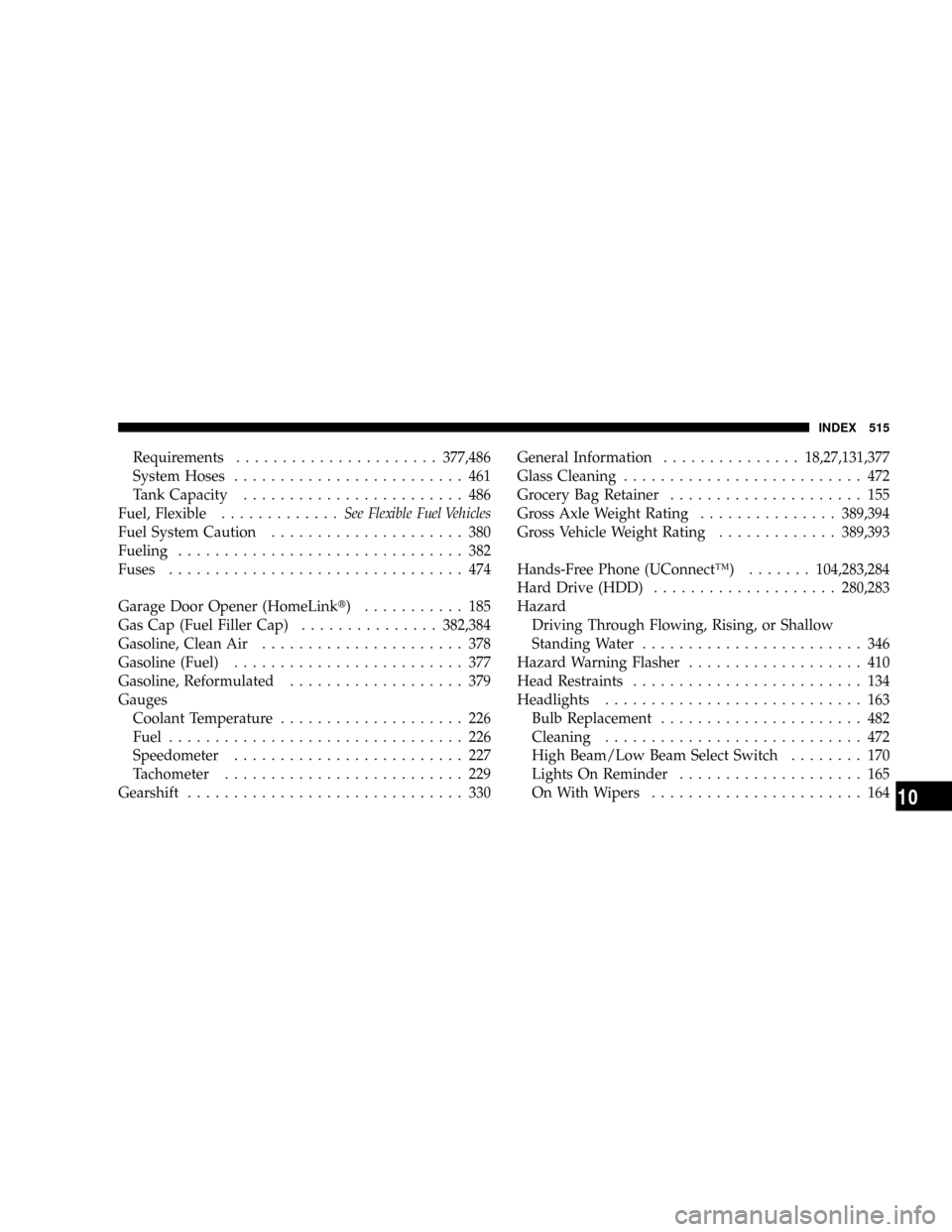
Requirements......................377,486
System Hoses......................... 461
Tank Capacity........................ 486
Fuel, Flexible.............See Flexible Fuel Vehicles
Fuel System Caution..................... 380
Fueling............................... 382
Fuses................................ 474
Garage Door Opener (HomeLinkt) ........... 185
Gas Cap (Fuel Filler Cap)...............382,384
Gasoline, Clean Air...................... 378
Gasoline (Fuel)......................... 377
Gasoline, Reformulated................... 379
Gauges
Coolant Temperature.................... 226
Fuel................................ 226
Speedometer......................... 227
Tachometer.......................... 229
Gearshift.............................. 330General Information...............18,27,131,377
Glass Cleaning.......................... 472
Grocery Bag Retainer..................... 155
Gross Axle Weight Rating...............389,394
Gross Vehicle Weight Rating.............389,393
Hands-Free Phone (UConnectŸ).......104,283,284
Hard Drive (HDD)....................280,283
Hazard
Driving Through Flowing, Rising, or Shallow
Standing Water........................ 346
Hazard Warning Flasher................... 410
Head Restraints......................... 134
Headlights............................ 163
Bulb Replacement...................... 482
Cleaning............................ 472
High Beam/Low Beam Select Switch........ 170
Lights On Reminder.................... 165
On With Wipers....................... 164
INDEX 515
10